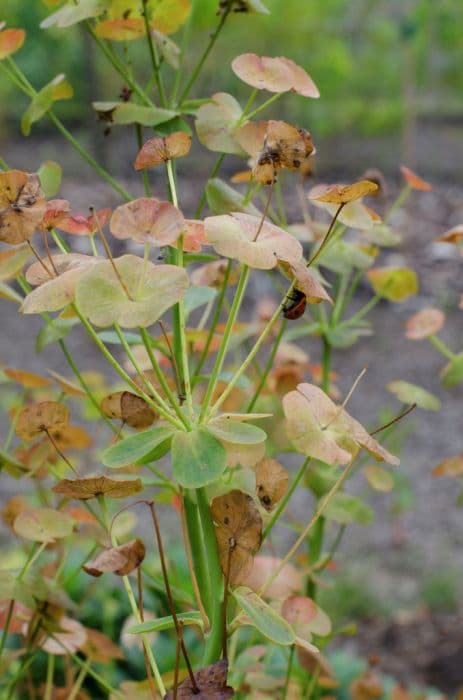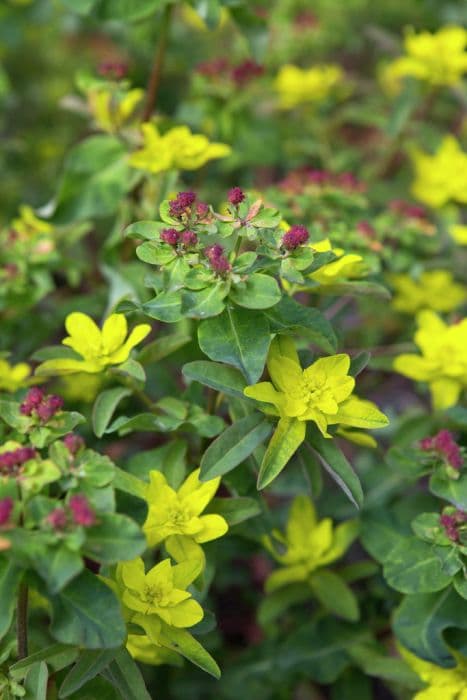Honey Spurge Euphorbia mellifera

ABOUT
The plant known as honey spurge is an evergreen shrub with a dense and bushy appearance, characterized by its robust branching structure. It bears slender, lance-shaped leaves that have a glossy dark green color, arranged in whorls and spiral patterns along the stems which enhance its dense foliage. These leaves have a striking texture and often exude a light, sweet scent especially noticeable in warmer seasons. The flowers of honey spurge are small and appear in the form of clusters. These clusters take the shape of compound umbels with a rich honey-like fragrance from which it derives its common name. The flowers are typically a subtle greenish-yellow, which contrasts nicely against the dark foliage. They bloom profusely, and their fragrance is known to attract various pollinators such as bees. Honey spurge does not produce any prominent fruits; instead, it has inconspicuous three-lobed capsules. One of the notable features of honey spurge is its milky sap that is present in all parts of the plant. This sap is a characteristic feature of the spurge family and can be seen when any part of the plant is broken or cut. While this sap is integral to the plant's system, it is worth noting that it can be irritating to the skin and must be handled with care. The overall appearance of honey spurge is lush and vibrant, making it a popular choice for gardeners looking to create a green and aromatic backdrop or to fill in spaces with evergreen foliage.
About this plant
 Names
NamesSynonyms
Canary Spurge, Honey Spurge.
Common names
Euphorbia mellifera.
 Toxicity
ToxicityTo humans
Honey spurge contains toxic compounds, specifically in its milky sap which is present throughout the plant. If the sap comes into contact with the skin, it may cause irritation, redness, swelling, and blistering. If it contacts the eyes, it can lead to serious eye irritation or damage. Ingesting any part of Honey spurge can cause gastrointestinal symptoms such as nausea, vomiting, and diarrhea. In severe cases, ingestion could lead to more serious systemic effects, and medical attention should be sought if ingestion or serious contact occurs.
To pets
Honey spurge is toxic to pets due to the same toxic milky sap it carries that affects humans. If pets come into contact with the sap, it can cause skin irritation, and if it gets in their eyes, it may cause severe eye pain and irritation. Ingestion of Honey spurge by pets can cause symptoms such as vomiting, diarrhea, and drooling. In severe cases, ingestion could lead to more serious health issues, and prompt veterinary care should be sought.
 Characteristics
CharacteristicsLife cycle
Perennials
Foliage type
Evergreen
Color of leaves
Green
Flower color
Yellow
Height
6 feet (1.83 meters)
Spread
5 feet (1.52 meters)
Plant type
Shrub
Hardiness zones
9
Native area
Canary Islands
Benefits
 General Benefits
General Benefits- Attracts Pollinators: Euphorbia mellifera is known to attract bees, butterflies, and other beneficial insects due to its nectar-rich flowers.
- Drought Tolerant: Once established, the plant is drought-resistant, making it suitable for xeriscaping and low-water gardens.
- Aesthetic Appeal: It has an attractive form and foliage, and its flowers have a pleasant honey scent, enhancing garden aesthetics.
- Erosion Control: The plant’s root system can help stabilize soil and prevent erosion on slopes.
- Low Maintenance: It requires minimal care once established, thus reducing the need for frequent watering and fertilizing.
- Wildlife Habitat: Provides shelter and food for various forms of wildlife besides pollinators.
- Architectural Interest: Its structural form makes it a great focal point or background plant in landscape designs.
- Wind Resistant: Can tolerate and act as a windbreak in coastal and exposed sites due to its sturdy nature.
 Medical Properties
Medical PropertiesThis plant is not used for medical purposes.
 Air-purifying Qualities
Air-purifying QualitiesThis plant is not specifically known for air purifying qualities.
 Other Uses
Other Uses- Euphorbia mellifera, commonly known as Honey Spurge, can be used as a natural barrier due to its dense growth habit, making it effective for creating privacy or dividing spaces in gardens.
- Its sap contains latex which has been explored as a renewable resource for bio-based materials, although this practice is not common due to potential skin irritations from the sap.
- Honey Spurge can be used in companion planting, offering a protective environment against pests for more vulnerable plant species.
- The plant's vigorous growth can be instrumental in preventing soil erosion on sloped landscapes, making it useful for ecological landscaping.
- Its unique architectural form, with upright stems and whorled leaves, makes Honey Spurge an excellent candidate for creating focal points in modern, minimalist garden designs.
- Honey Spurge can be utilized in hedges or windbreaks in coastal areas, as it is tolerant of sea spray and wind.
- The dried seed pods and stems of Honey Spurge provide interesting textures and shapes for use in floral arrangements and decorative dried flower crafts.
- Gardeners may use the distinctive foliage of Honey Spurge to add a contrasting element against softer, round-leaved plants in garden compositions.
- Due to its drought-tolerant properties, Honey Spurge is suitable for xeriscaping, a landscaping method that reduces the need for supplemental water from irrigation.
- The flowering of Honey Spurge creates an early season nectar source, offering an unusual but beneficial planting choice for supporting pollinators such as bees in the spring garden.
Interesting Facts
 Feng Shui
Feng ShuiHoney spurge is not used in Feng Shui practice.
 Zodiac Sign Compitability
Zodiac Sign CompitabilityHoney spurge is not used in astrology practice.
 Plant Symbolism
Plant Symbolism- Abundance – Euphorbia mellifera, commonly known as Honey Spurge, produces abundant nectar, symbolizing richness and the flow of blessings.
- Attraction – Its sweet scent is known to attract pollinators, representing the power of attraction and the ability to allure what one desires.
- Protection – Like many Euphorbias, Honey Spurge exudes a milky sap when cut, which can be toxic. This symbolizes protection and the ability to ward off negative influences.
- Adaptability – Being able to thrive in various conditions, Honey Spurge symbolizes adaptability and resilience in different environments.
 Water
WaterThe Honey Spurge should be watered moderately, allowing the soil to dry out slightly between waterings. Typically, during the growing season in spring and summer, watering once a week with approximately 1 gallon of water per plant should suffice, depending on the size and environmental conditions. In fall and winter, reduce watering frequency to every other week or less, as the plant requires less moisture when it's not actively growing. Be careful not to overwater, as this can lead to root rot. Use water at room temperature to avoid shocking the plant's roots.
 Light
LightThe Honey Spurge thrives in a location that receives full to partial sunlight. Ideally, it should be placed in a spot where it gets at least 4 to 6 hours of direct sunlight daily, but can also tolerate some shade. Avoid deep shade as it can lead to poor growth and fewer flowers. East or west-facing locations are generally suitable for providing the right light balance for this plant.
 Temperature
TemperatureThe Honey Spurge prefers temperatures between 50 and 77 degrees Fahrenheit. It can survive minimum temperatures down to about 25 degrees Fahrenheit, but frost can damage the plant, so it's best to provide some protection if a hard freeze is expected. Optimal growth occurs when the temperature is consistently warm; sudden cold snaps can be detrimental to the health of the plant.
 Pruning
PruningPrune Honey Spurge to shape the plant, control its size, and remove any dead or diseased branches. The best time to prune is in late winter or early spring before the onset of new growth. Pruning should be done sparingly, as Euphorbia mellifera has a natural and attractive shape. Ensure to wear gloves and protect your eyes, as the sap can be an irritant.
 Cleaning
CleaningAs needed
 Soil
SoilHoney Spurge thrives best in a soil mix comprising equal parts of loam, peat, and sharp sand, promoting good drainage. The soil pH should be neutral to slightly acidic, around 6.0 to 7.5 for optimal growth.
 Repotting
RepottingHoney Spurge should be repotted every 2 to 3 years to ensure the plant has enough room for growth and to refresh the soil, which can become compacted and nutrient-depleted over time.
 Humidity & Misting
Humidity & MistingHoney Spurge prefers moderate humidity levels, typical of indoor environments, without the need for extra humidity measures. Avoid overly humid conditions as they can promote fungal growth.
 Suitable locations
Suitable locationsIndoor
Place Honey Spurge in bright, indirect light with some direct sun.
Outdoor
Situate Honey Spurge in partial shade to full sun, sheltered from cold winds.
Hardiness zone
9-11 USDA
 Life cycle
Life cycleEuphorbia mellifera, commonly known as honey spurge or canary spurge, begins its life cycle as seeds, which upon germination in suitable conditions of light, temperature, and soil moisture, give rise to young seedlings. The seedlings develop a taproot and begin to grow their first pair of leaves, eventually producing a tough, woody stem. As the plant matures, it develops a branching structure and thick, evergreen leaves, which allow it to photosynthesize and grow year-round in its native subtropical to temperate climates. Honey spurge eventually blossoms in early to late spring, producing small, honey-scented flowers that are grouped within cup-shaped bracts, attracting pollinators. Following pollination, the plant develops fruit capsules which, upon ripening, explosively release seeds, thus completing the reproductive stage and allowing the life cycle to start anew. Over time, Euphorbia mellifera can grow into a sizeable shrub, reaching up to 2 meters in height and spreading through both seed dispersal and root suckers, potentially forming dense thickets if left unmanaged.
 Propogation
PropogationPropogation time
Spring-Early Summer
The most popular method for propagating the Honey Spurge (Euphorbia mellifera) is through seed sowing. Seeds should be collected after the capsules have ripened and split open, typically in late summer. It is recommended to sow them immediately as they are freshest and their viability is highest at this time. Sowing can be done in a well-draining seed starting mix, covering the seeds lightly with the soil. The pot should be kept in a warm place with a steady temperature of around 70°F (approx. 21°C) and the soil should be kept moist but not waterlogged. Seedlings will need to be potted on once they have developed their first true leaves and can eventually be moved outdoors after the risk of frost has passed.


![Spurge [Silver Swan]](/_next/image?url=https%3A%2F%2Fplants-admin.emdemapps.com%2Fimages%2Fplants%2F%2Fimages%2F604b573f6c8f6.png&w=640&q=75)






